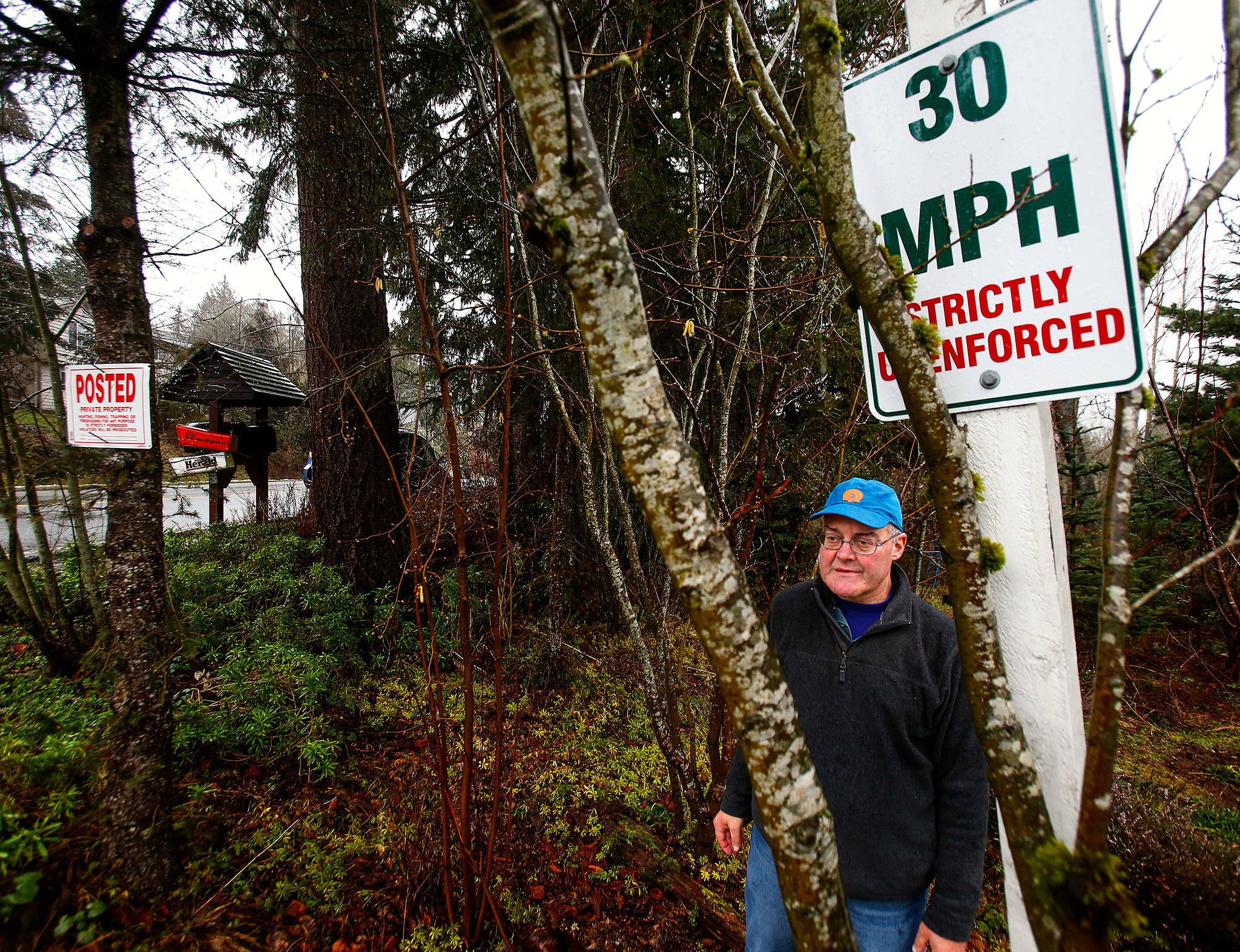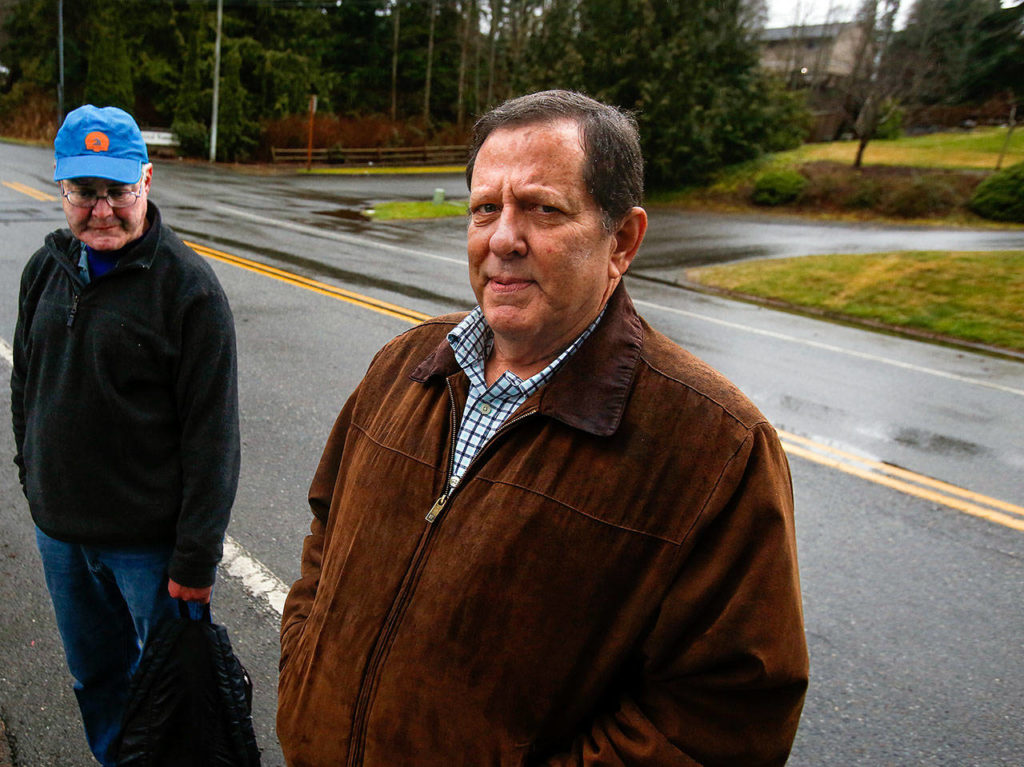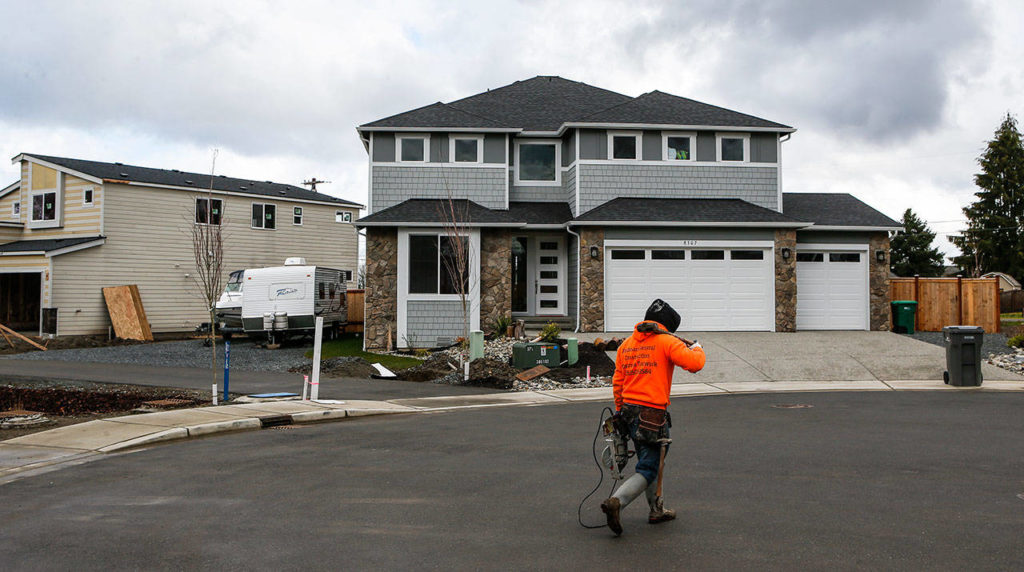LAKE STEVENS — When Dick Todd moved to his home more than 30 years ago, the neighborhood southwest of the lake had a chicken farm and a dirt road leading to an old cabin shaded by trees.
At the time, 99th Avenue SE was a quiet, two-lane road in unincorporated Snohomish County, not far from the small city of Lake Stevens.
Now, take a stroll in either direction from Todd’s place and you’ll see new rooftops or clearings full of construction equipment. The city annexed his neighborhood seven years ago. Since then, development has exploded.
“This is the crucial tipping point,” Todd said.
Lake Stevens, the fastest-growing city in Snohomish County for nearly two decades, is going through another spurt. Some long-timers, like Todd, decry the change in scenery, worsening traffic and loss of natural landscapes. They fear a place they love is slipping away, as development remakes its character.
Leaders in city government say they have to handle the growth headed their way. They believe they’re doing a good job of it, the increasing traffic notwithstanding. Developers note the area’s relatively low home prices, good schools and overall quality of life. They warn that land for new houses will run out, leading to sticker shock and longer commutes for families in search of a home.
Five times the people
Since 2000, Lake Stevens has quadrupled in size and nearly quintupled in population. The city gobbled up land with annexations, and the population has climbed steadily. It went from the 13th largest city in Snohomish County, by population, to the fifth, overtaking Snohomish, Monroe, Arlington, Mill Creek, Mountlake Terrace, Mukilteo, Bothell and Brier.
There were 6,361 people living in Lake Stevens in 2000. By 2016, there were 30,900. Between 2015 and 2016 alone, the city added 1,000 people.
In comparison, Marysville is two-and-a-half times more populated than in 2000. No other city in the county doubled in population, according to state counts.
Lake Stevens also brings in more money than it once did. In 2000, revenues totaled about $6.1 million, including $755,000 from property taxes. This year’s budget anticipates $29.4 million, with $4.5 million from property taxes, a sixfold increase.
Sales of single-family homes are through the roof. Still, Lake Stevens isn’t quite a match for the unincorporated North Creek area east of Bothell, which leads the state in new home sales.
The Northwest Multiple Listing Service tracked 1,160 sales with a Lake Stevens address in 2016, up from 904 in 2015. During the first quarter of 2017, 226 homes sold. The median price pushed above $360,000. Developers expect to see that go up with competition for contractors and land, along with permit costs.
Though neighbors tend to hope for upscale homes on large lots, those aren’t within reach of most buyers, developers say. They have to build to the market. That means smaller homes in denser neighborhoods.
Todd wishes more thought went into the placement of houses, parks and streets. He envisions neighborhoods with open spaces where people do more outside than get in and out of their cars for the worsening commute.
“This isn’t a community,” he said.
John Spencer, Lake Stevens mayor since 2016, has lived in the city for more than 30 years. Like Todd, he’s seen the changes.
He understands concerns about traffic and the changing landscape, but the city can’t chase away builders who want to put houses on property zoned for just that, he said.
“I don’t know what to tell people who fundamentally don’t want this type of development,” Spencer said. “It’s not something where you can take sides. You can’t put a cork in this.”
The hot spot
The 20th Street corridor, including 99th Avenue, is the city’s hot spot. Orange silt fences rim dirt lots full of excavators and dump trucks. Signs tout future three- and four-bedroom homes “from the $300’s” and “$400’s.”
The population swell opens the door for downtown redevelopment, expanded parks and more shopping options. But fast-paced growth can bring problems as well as boons.
Roads are jammed. Local governments lack the money to keep up with improvements. Once-rural routes have become part of the daily commute for thousands of suburbanites. Side roads are choked where they meet 20th Street or Highway 9. There’s the notorious bottleneck of the Trestle, funneling traffic from 20th, U.S. 2 and Highway 204. Upwards of 40,000 vehicles head east on the Trestle each day. Backups of a mile-plus are “par for the course,” Todd said.
The 65-year-old started confronting the city with his concerns in 2015. He went to a public hearing about a development abutting his 8-acre property. He’s since been in regular contact with the city. In the fall, he put up a fake speed-limit sign along 99th. It said, “30 mph strictly unenforced.” The city removed it as a non-permitted sign in a public right of way. Todd got his sign back, and put it in a less-conspicuous spot.
Though Todd’s initial focus was the roads, he’s found more to worry about. He noted muddy runoff into Stitch Creek, ponds and wetlands near his home.
Department of Ecology inspectors found turbid, or muddy, water running from construction sites. Among them are Westlake Crossing, Eagle Glen and Maple Rock II on 99th. Ponds meant to contain stormwater were overflowing by December. Runoff wasn’t monitored along property lines, and barriers to limit or filter it were lacking.
Too much sediment in water can harm fish and insects, suffocate vegetation and block light to aquatic organisms.
Stormwater problems are common on construction sites, inspector Ben Billick said. With soil made of fine sediment, rain poses a challenge during builds.
There are benchmarks for how turbid water should be. Exceeding them is not a violation of the developer’s permit unless workers fail to fix problems.
Samples earlier this year at Eagle Glen showed runoff up to 20 times murkier than the benchmark, according to ecology reports. A spokesman from Lennar, the developer, said workers have taken steps to address concerns.
A sewer project related to Eagle Glen but handled by a different builder recently ran into trouble. The crew was operating without a necessary permit and was told to apply for one, which it did. There have been problems with erosion and oil leaking from equipment that wasn’t immediately fixed. Inspectors gave a “stern warning” to the contractor and city for allowing issues to persist, according to a Lake Stevens Sewer District report. There also were state worker safety violations related to employees working in an unsecured trench.
At Westlake Crossing, samples from 2016 measured up to 25 times the turbidity benchmark. Inspectors issued a notice of corrections required, such as better monitoring and prevention. Overly turbid runoff also was recorded at Maple Rock II by D.R. Horton. A spokeswoman with the developer noted that heavy rains this winter were unusual weather and that the projects have not been shut down or fined.
To address runoff, workers set up a system that pumps water through a filter before it leaves the property. Neighbors have complained about noise from the pump.
Hungry for growth
Todd’s neighbor Mike Fear, 63, has lived on 99th for about 15 years. His background is in development, mainly industrial properties. He worked as a self-described “dirt dog,” connecting builders with land.
Fear understands the need for new homes, but wants builders to play by the rules. The pace of building shouldn’t outstrip regulators’ ability to track problems.
“People are moving into this area, and people get a benefit out of a better economy. I know I do,” he said. “I just think Lake Stevens doesn’t have 52 cards in their deck.”
Fear says that when ordinary people try to oppose developments, it’s hard to get officials to take notice.
“There are two ways to do that: Either spend enough time to be a pain in the butt or have enough money to hire a lawyer,” Fear said.
He believes the city is hungry for growth and intent on the revenue.
Some locals worry the building frenzy will end like the last one nearly a decade ago: with a bust. Lake Stevens-based Barclays North was one of the county’s largest developers in those days, buying up thousands of lots. CEO Patrick McCourt kept a low public profile after the company went out of business in 2008, but has since reappeared at city meetings to talk about other developers’ projects.
Spencer says the city takes planning and budgeting for growth seriously. People are moving to the area, and cities around the county are adjusting to the influx. They have to provide housing and services. In Lake Stevens, a consultant is researching how much it would cost to serve more than 1,700 households at the southeast corner of the lake prior to their potential annexation.
The way ahead
Road improvements are among the most crucial needs.
Designs are in the works to widen parts of 20th Street. State lawmakers recently set aside $350,000 to study rebuilding the U.S. 2 Trestle. Engineers have been gathering feedback on a $69.5 million overhaul of the intersection of highways 9 and 204. City leaders have been vocal about the needs.
“We are extremely aware of the transportation problem,” Spencer said. “But for people to say you’re just letting houses go without taking care of the transportation issues, that’s not a complete picture.”
Money comes in for local roads as builders pay traffic impact fees, he said.
That’s not the only sum developers shell out — and that’s driving up prices.
Stormwater control is one of the largest, said Sunshine Kapus, director of operations at Gamut360. The local builder averages about 60 homes a year.
There used to be more local developers than national corporations, but that’s flipped, Kapus said.
Lack of available land, high permitting fees and wait times complicate projects, she said. There are fees for water, sewer, traffic and parks, totaling tens of thousands of dollars. With increasing construction and land costs, houses sell at higher prices.
“If a project doesn’t pencil, it gets pushed off another few years,” she said. “You’ve got to keep the new homes coming to keep the funds.”
Home-building isn’t keeping up with population.
Demographers expect Snohomish County to grow by about 10,000 people per year over the next two decades. Growth spiked much higher than that since 2013.
Cities will have to take an increasing portion of the future housing stock. Lake Stevens has been taking its share.
Classrooms are crowded, according to the Lake Stevens School District, which just updated its policies regarding capacity. There’s no room to accept out-of-district students, even those who already have been in Lake Stevens schools for several years.
Full circle
Meanwhile, Lake Stevens plans to annex the rest of its urban growth area and could fully circle its namesake lake within a few years.
“This is where the rub comes with people who have been here a long time,” Spencer said. “This is a beautiful area. It’s a beautiful lake, beautiful old growth timber, and when they see that coming down … I understand the angst, but I can’t stop growth.”
It won’t continue forever.
Darin Huseby was active in Lake Stevens-area development before starting his own company, Huseby Homes. He sees prices going up, as the supply of large, flat lots dwindles.
“There’s just not enough dirt for all the players in town,” he said. “Everybody’s fighting for the same pieces of ground.”
Increasingly, builders are forced to work on smaller infill projects and land with streams, steep slopes or other costly obstacles.
While developers scramble to snag available land, neighbors such as Todd and Fear worry quality is being sacrificed for speed and profit. As long as Lake Stevens remains popular for developers, they plan to keep an eye on them.
Huseby, though, expects the city’s supply of buildable land to dry up.
“Lake Stevens still has a fair amount of dirt to work through,” he said, “but they’re getting close to the end.”
Noah Haglund: 425-339-3465; nhaglund@heraldnet.com. Kari Bray: 425-339-3439; kbray@heraldnet.com
Talk to us
> Give us your news tips.
> Send us a letter to the editor.
> More Herald contact information.



























